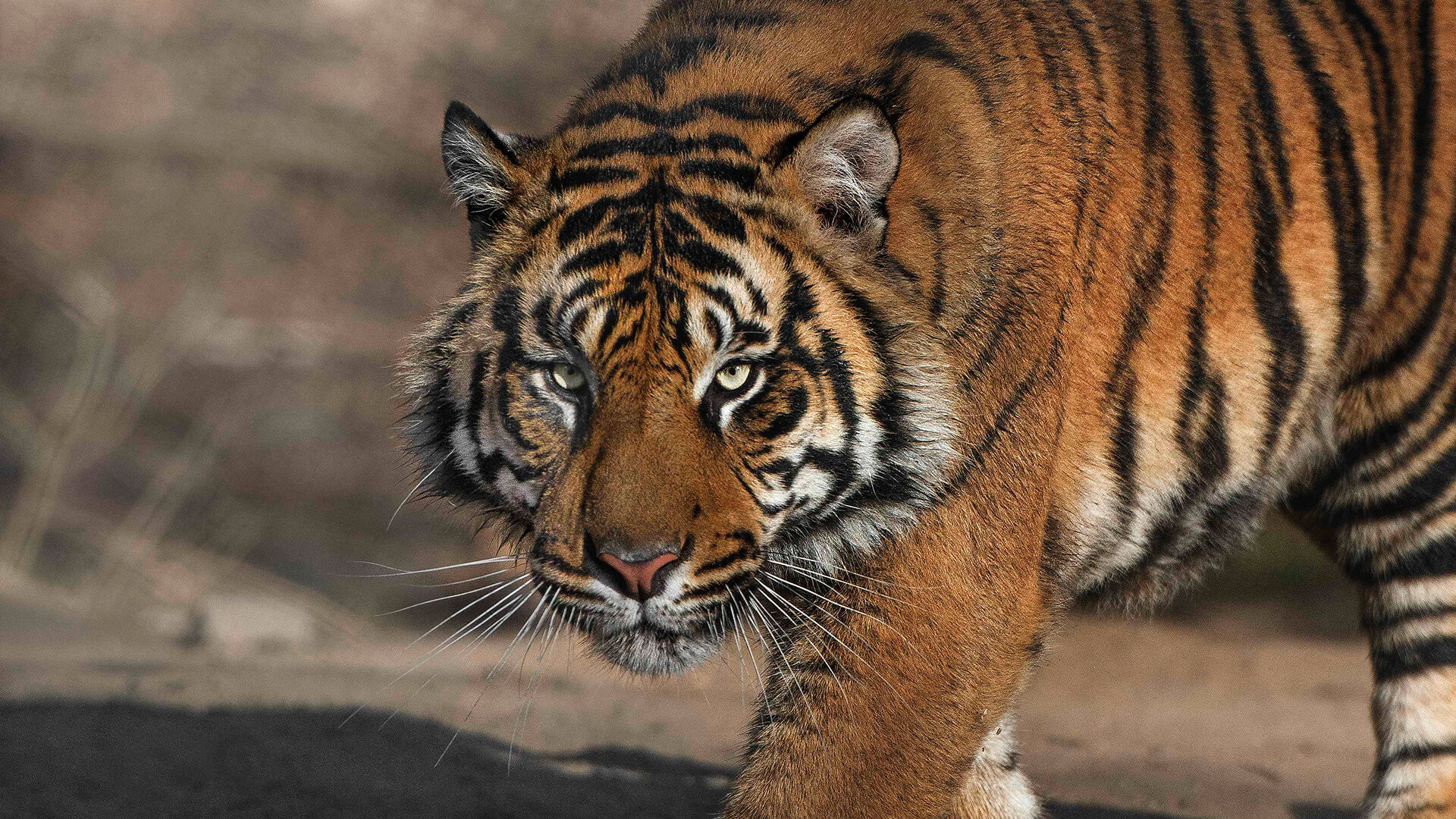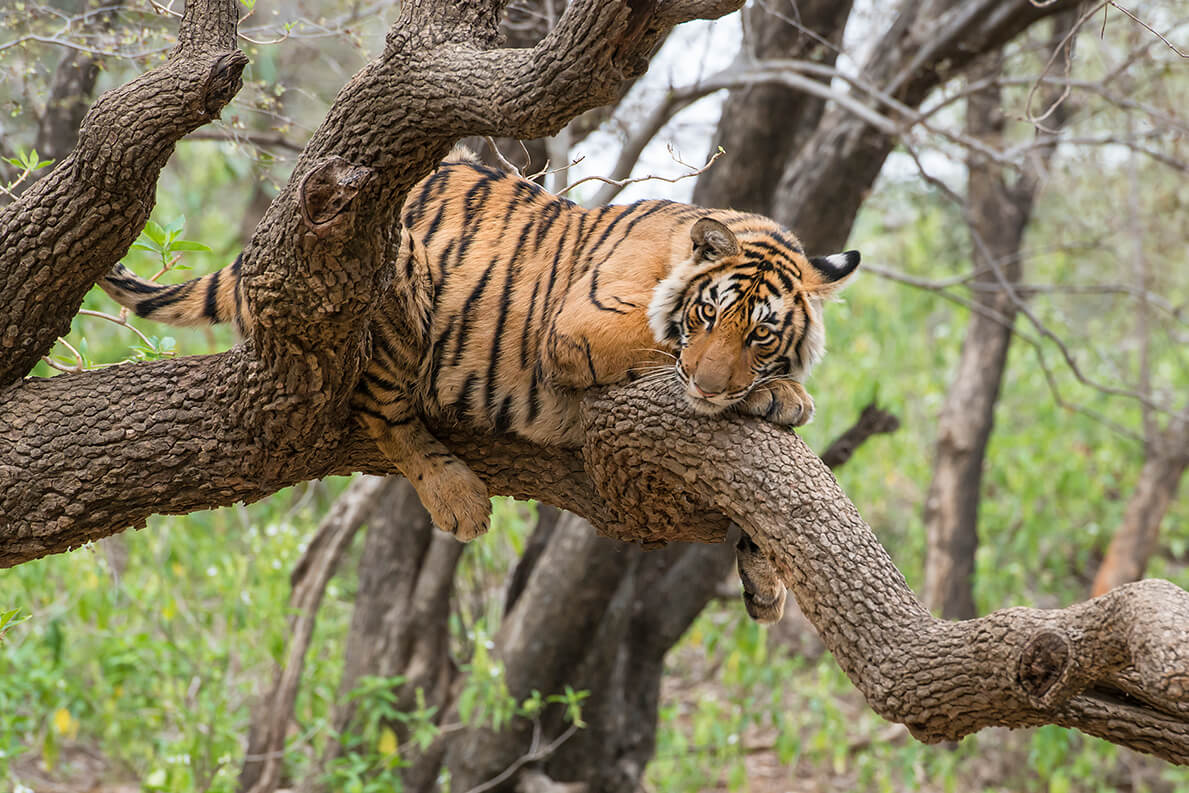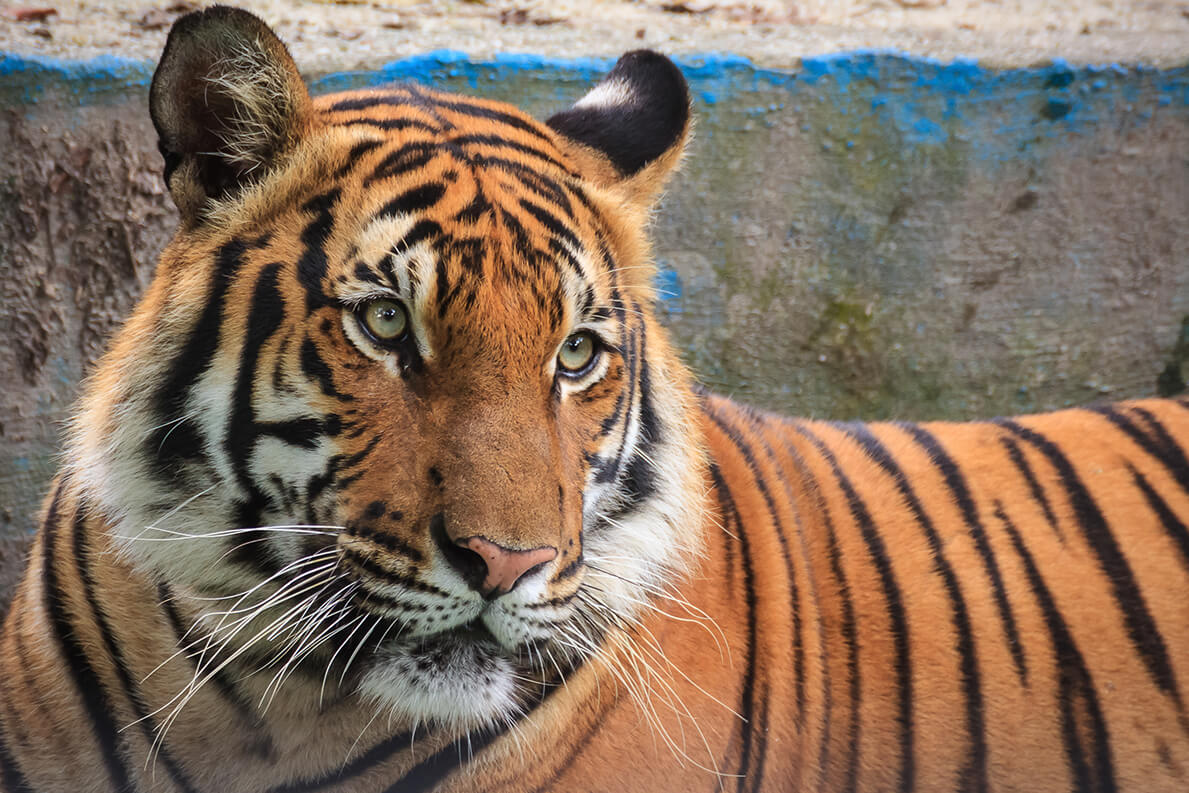
Tiger

- CLASS: Mammalia (Mammals)
- ORDER: Carnivora
- FAMILY: Felidae
- GENUS: Panthera
- SPECIES: tigris
- SUBSPECIES: 6

ABOUT
With vibrant, striped coats and powerful, mesmerizing eyes, tigers inspire awe and reverence. It’s a reverence that’s mixed with a bit of fear, an appropriate reaction to a large, well-muscled, swift hunter with 1- to 2-inch-long canine teeth and 3- to 4-inch-long claws. Tigers are stalk-and-ambush hunters, and their distinctive stripes are good camouflage in the long grass or wooded forests of their diverse habitats. Dark stripes on a pale background break up a tiger’s outline as it lies in wait for prey to come near.
Tigers can also be black with tan stripes, all white (albino), or white and tan. “White tigers” cared for in some zoos are not albino but rather white-and-tan with blue eyes (true albinos have pink eyes).
HABITAT AND DIET
There are currently six subspecies of tigers, each living in different habitats: flooded mangrove forests, arid forests, tropical forests, and taiga. The different subspecies live in small areas of Asia, India, and Russia. The largest subspecies lives in snowy areas of Russia. The smallest and darkest subspecies is found farther south, in the jungles of Indonesia. Female tigers are always smaller than males.

Amur or Siberian tiger Panthera tigris altaica: The largest of the tiger subspecies, males can be 12 feet (3.7 meters) long. That’s nearly as long as the average car! Amur tigers also have the palest orange coat and the fewest stripes, to help them blend in with their snow-covered habitat. As it lives in a very cold climate, an Amur tiger’s coat grows longer and thicker than other tiger subspecies, coveringa layer of fat for insulation. Their home range is in eastern Russia and northeastern China.

Bengal or Indian tiger Panthera tigris tigris: The largest of the tiger subspecies, males can be 12 feet (3.7 meters) long. That’s nearly as long as the average car! Amur tigers also have the palest orange coat and the fewest stripes, to help them blend in with their snow-covered habitat. As it lives in a very cold climate, an Amur tiger’s coat grows longer and thicker than other tiger subspecies, coveringa layer of fat for insulation. Their home range is in eastern Russia and northeastern China.

Indochinese tiger Panthera tigris corbetti: Indochinese tiger Panthera tigris corbetti: These tigers are about 20 percent smaller than Bengal tigers, and they are darker. Indochinese tigers live in Southeast Asia.

Malayan tiger Panthera tigris jacksoni: This is the subspecies you’ll see at the San Diego Zoo. Conservation scientists believe their populations are in steep decline in Malaysia.

Sumatran tiger Panthera tigris sumatrae: Even though Sumatran tigers are the smallest subspecies,they’re still pretty large. Imagine a tiger the same length as a school cafeteria table! Their orange coats are darker than other subspecies, as they’re native to dark jungle habitats on the island of Sumatra. The sides of their faces have longer fur, perhaps as protection against jungle plants. Sumatran tigers are critically endangered. These are the tigers we care for at the San Diego Zoo Safari Park.
South China tiger Panthera tigris amoyensis: South China tigers are slightly smaller than the Indochinese subspecies. People have not observed this subspecies in the wild since the 1970s and conservation scientists believe they may be extinct.
Tigers are seldom far from a water source. Excellent and powerful swimmers, tigers are often found during the day relaxing or waiting to ambush prey in ponds, streams, and rivers. They seek out water to swim while most other cats avoid it. Tigers even have partially webbed toes and aren’t discouraged by a river if there is prey on the other side.
A tiger’s front paws are large and strong to bring down prey. Their claws can be pulled inside while the tiger walks, which helps keep them sharp. Tigers also use their claws to mark their territory by scratching on trees. Conveniently, this also sharpens their claws.
Tigers are patient hunters and can move slowly and quietly, stalking their prey (usually ungulates like deer and pigs) for 20 or 30 minutes. A tiger’s large canine teeth and powerful jaws are used to grab its prey by the neck and suffocate it. Tigers use their sandpaper-rough tongues to scrape the last bits of meat from the bones of a meal. A tiger makes a kill once or twice a week and eats as much as it can. Using its paws, it then covers the leftovers with grass and dirt to hide it from vultures and other scavengers. The tiger returns to the kill over the next few days for smaller snacks. They prefer pigs and deer, but in some parts of Asia a tiger may bring down a rhino or elephant calf.
At the San Diego Zoo and the San Diego Zoo Safari Park, tigers eat whole prey, a variety of meat, and large bones as part of their comprehensive nutrition and wellness.
FAMILY LIFE
Tigers are generally solitary cats, unless a female is caring for her cubs, and maintain a home range that can be several square miles, depending on habitat and the amount of prey available; males tend to have larger territories than females. Siberian tigers have the largest range (more than 4,000 square miles or 10,000 square kilometers have been recorded) as food is scarcer, so they have to travel farther to secure a meal. Some tigers defend their territory from other tigers while others often share their range.
A female tiger in estrus leaves urine “messages” on trees and other places to let males know her reproductive status. Through loud moaning calls, a male and female can find each other for breeding and may stay together for a few days before going their separate ways. Tiger cubs are born small and helpless, but the mother must leave them alone while she hunts. A female can have a litter of up to seven cubs every two years. Typically, she cannot kill enough prey to feed so many hungry cubs, so usually only two cubs survive. Up to half of tiger cubs do not survive their first year, succumbing to starvation, disease, competition for prey, accidents, and injuries while hunting. They begin to hunt when they’re very young—joining their mother at just eight weeks old, and then learning how to kill cattle, deer, and pigs at six months old.

Cubs seem to know from the start that they are tigers and practice their hunting skills with each other in what could be considered a form of extreme tag, since the cubs chase, tackle, and wrestle each other, growling ferociously all the while. They often practice ambush skills on their resting mother! Most tiger cubs are weaned when they are about five or six months old, but they usually stay with their mother for about two years and don’t hunt on their own until they leave.
Although not as social as lions, tigers vocalize more frequently and have a wide range of vocalizations, including roars, grunts, hisses, and chuffs. Tigers roar when challenging other tigers at long range, defending a meal, or attracting a breeding partner; a chuff indicates a friendly greeting, usually used between a mother and her cubs. Other forms of tiger communication include spraying urine, leaving piles of feces where they can be seen, and clawing trees or the ground—all to say “this area is mine!”
AT THE ZOO
We have the honor of caring for Malayan tigers at the San Diego Zoo and Sumatran tigers at the San Diego Zoo Safari Park.
The Safari Park's state-of-the-art Tiger Trail features forest clearings, tiger viewing areas, and a pool for tigers. You can even watch them from home through our Tiger Cam.
CONSERVATION
Conservation scientists estimate that only about 3,000 tigers remain in the world today. Poaching, habitat loss and fragmentation, coexistence challenges, and disease contribute to their continual decline. Sadly, poaching poses the largest threat. For many years, tigers have been hunted for their fur and other body parts, some of which are used for perceived, but unproven, medicinal properties. In some cultures, people poach tigers for sport or to demonstrate their own bravery. Despite legal protections, tiger poaching continues today because parts and products can be illegally sold for a high value.
Tigers also suffer from habitat loss and fragmentation. When people move into areas where tigers live, tigers are forced into smaller and more isolated areas where there may not be enough food or available mates. As growing infrastructure, farms, plantations, and logging operations expand, tiger habitats shrink. They face more encounters with people, and often, more conflict.
Fortunately, there are things we can do to help protect tigers. Many countries around the world, including the U.S., have passed laws to stop the sale of products made from tiger parts. You can help protect tigers by avoiding products made from tigers, helping raise awareness, and supporting tiger conservation organizations such as accredited zoos.
Through our Asia Conservation Hub, San Diego Zoo Wildlife Alliance collaborates with partners in Indonesia to study the ecology of Sumatran tigers. We closely observe their habitat use and travel patterns, learning from their paw prints, scat (feces), DNA samples, trail camera photos, and GPS data. We work closely with Indonesian government agencies to provide technical support and training for young Indonesian conservationists and government officials, too.
At the San Diego Zoo and San Diego Zoo Safari Park, we combine our experience in wildlife care with our expertise in conservation science to collaborate with international partners to develop strategic solutions for tigers. We’re learning about tiger reproduction by correlating a tiger’s reproductive behavior and success with their hormone levels. This research forms an essential part of our commitment to maximizing the health of tigers in our care, as well as supporting our field research efforts in Sumatra.
By joining San Diego Zoo Wildlife Alliance as an ally for wildlife, you help save species worldwide.
Sounds
LIFE SPAN
About 16 years on average
YOUNG
Gestation: About 103 days
Number of young at birth: Up to 7, but average is 2 to 3
Weight at birth: 2.2 pounds (1 kilogram)
Age of maturity: 3 to 6 years
SIZE
Length: 4.8 to 9.5 feet (1.5 to 2.9 meters), depending on gender and location. Males are larger than females.
Tail length: 2.3 to 3.6 feet (.7 to 1.1 meters)
Weight: 165 to 716 pounds (75 to 325 kilograms)
FUN FACTS
Each tiger has its very own stripe pattern. Conservation scientists who study tigers can identify individuals by their unique stripes.
Tigers can carry something twice their own body weight 10 feet (3 meters) up a tree.
A tiger’s night vision is six times better than ours.










